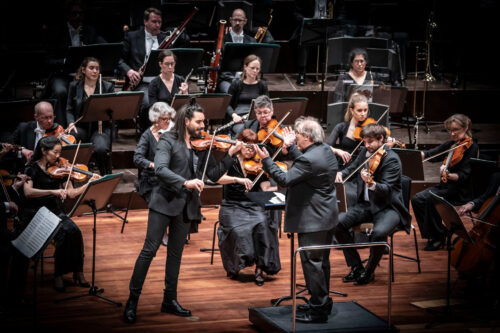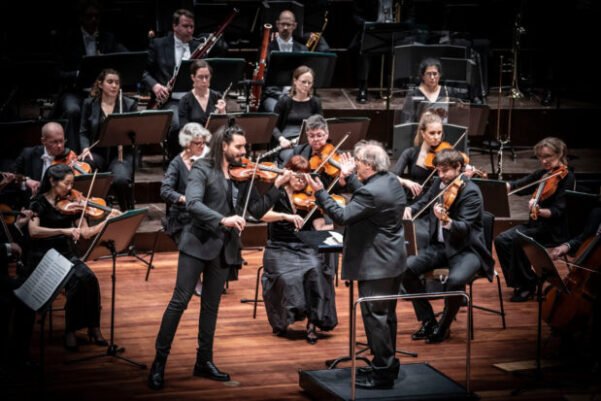 United Kingdom Linde, Khachaturian, Sibelius: Nemanja Radulović (violinist), Swedish Philharmonia / Jaime Martín (conductor). Usher Hall, Edinburgh, 19.3.2023. (GT)
United Kingdom Linde, Khachaturian, Sibelius: Nemanja Radulović (violinist), Swedish Philharmonia / Jaime Martín (conductor). Usher Hall, Edinburgh, 19.3.2023. (GT)

Linde – A Merry Overture, Op.14
Khachaturian – Violin Concerto in D minor
Sibelius – Symphony No.2 in D major, Op.43
The Swedish Philharmonia (also performing as Gävle Symphony Orchestra) are from the regional city of Gävle and made its impressive debut in Scotland in 2020 before the pandemic. They returned to Edinburgh with music by one of their own Gävle composers, Anders Bo Leif Linde (1933-1970). He studied with Lars Erik Larsson (1908-1986) and later in Vienna and was a prodigious pianist. After teaching in Stockholm, he returned to his hometown and ended his career there dying at the age of only 37. His early A Merry Overture was written in 1954 and shows evidence of his rich creativity, and also he composed two concertos for the violin and cello. He also worked as a music critic and teacher in Gävle.
The piece has associations with Malcolm Arnold, Bernstein and Shostakovich in the colourful woodwind passages and especially the flute. The invention is sparkling and festive, and I would certainly like to hear more of Linde’s music. It was evident how much the musicians enjoyed playing this brief piece, especially the woodwind group, with some colourful virtuosity from the flute of Julia Crowell, and the clarinet of Erik Larsson.
The music of Khachaturian is known mostly by his ballets – last month I mentioned in my review of the Armenian State Symphony’s concert here, that it would be good to hear one of his three concertos – and remarkably, his Violin Concerto from 1940 is here on the programme. I cannot recall hearing this work in concert, even by Russian orchestras. It is a technically challenging piece, yet in the young Serbian/French violinist Nemanja Radulović, we had a consummate master who possesses all the technical mastery and artistry required for this exotically romantic concerto.
In the Allegro con fermezza (opening movement) following the entry by the orchestra, the main theme announced by Radulović had a startlingly energetic, dance-like idea that yielded only to the lyrical secondary one evinced by the virtuosity of Crowell and Kristin Olsson on the flutes against the violins’ pizzicato. The violinist brilliantly tackled David Oistrakh’s own cadenza exhibiting its luxurious eastern rhythmic flavour in captivating duets with Larsson on the clarinet and the violin of concertmaster Peter Olofsson.
In the second movement (Andante sostenuto) the rhapsodic orchestral theme on the woodwind invoked a rather wintry landscape that was broken masterfully by the soloist finding the music’s free-flowing folk-based spontaneity, and especially in a beautifully sensitive passage of great intensity. There were wonderful solo passages from the bassoon of Patrik Häkansson and Lavinia Whitaker on the cor anglais bringing out even more of the exotic colours in the score.
The finale (Allegro vivace) opened with a surging fortissimo with a folk-dance vigour accompanying the solo passages by Radulović who unleashed a startling display of wildly exotic virtuosity through to the exuberant climax. Radulović clearly loves playing this piece and enjoys a great relationship with conductor Jaime Martín, who gave the soloist great support in bringing out all the beauty of Armenia’s folk melodies.
The Sibelius Second Symphony appears frequently in concert programmes, but it is always enlightening to hear an orchestra from Scandinavia bringing out all the dark romanticism of this masterpiece. Jaime Martín captured a wonderfully idyllic mood as the strings opened the Allegretto first movement, heralding exciting colours from the woodwind theme that was echoed by the horns; the feeling was that the woodwind were evoking a stroll across autumnal fields disturbed by wind and stormy clouds. A switch in the mood was masterfully handled by the Spanish conductor in the second movement (Tempo andante ma rubato) with the ominous bassoon theme from Häkansson and picked up by the brass. The strings introduced a rather melancholic idea, and darkness dominated the following passages as the composer appeared to reflect on the passing of his young daughter.
In the third movement (Vivacissimo) there was an ethereal passage with the oboe of Hanna Edqvist intoning a folk-like idea, before a brass fortissimo in the Trio and the return of the oboe theme. In the transition to the Finale (Allegro moderato) Martín conjured a transformation as the strings introduced an upbeat triumphant theme that was echoed by the brass and woodwind and despite the shadowy secondary idea, Sibelius’s stormy optimism took us towards a glorious culmination.
This was a terrific concert with two Scandinavian pieces: Linde’s interesting overture and the magnificent exotic virtuosity of the Khachaturian concerto with the brilliantly gifted Nemanja Radulović. I am sure that by the reaction of the audience, it will not be long before the Swedish Philharmonia – and the violinist too – make a speedy return to Scotland.
Gregor Tassie
